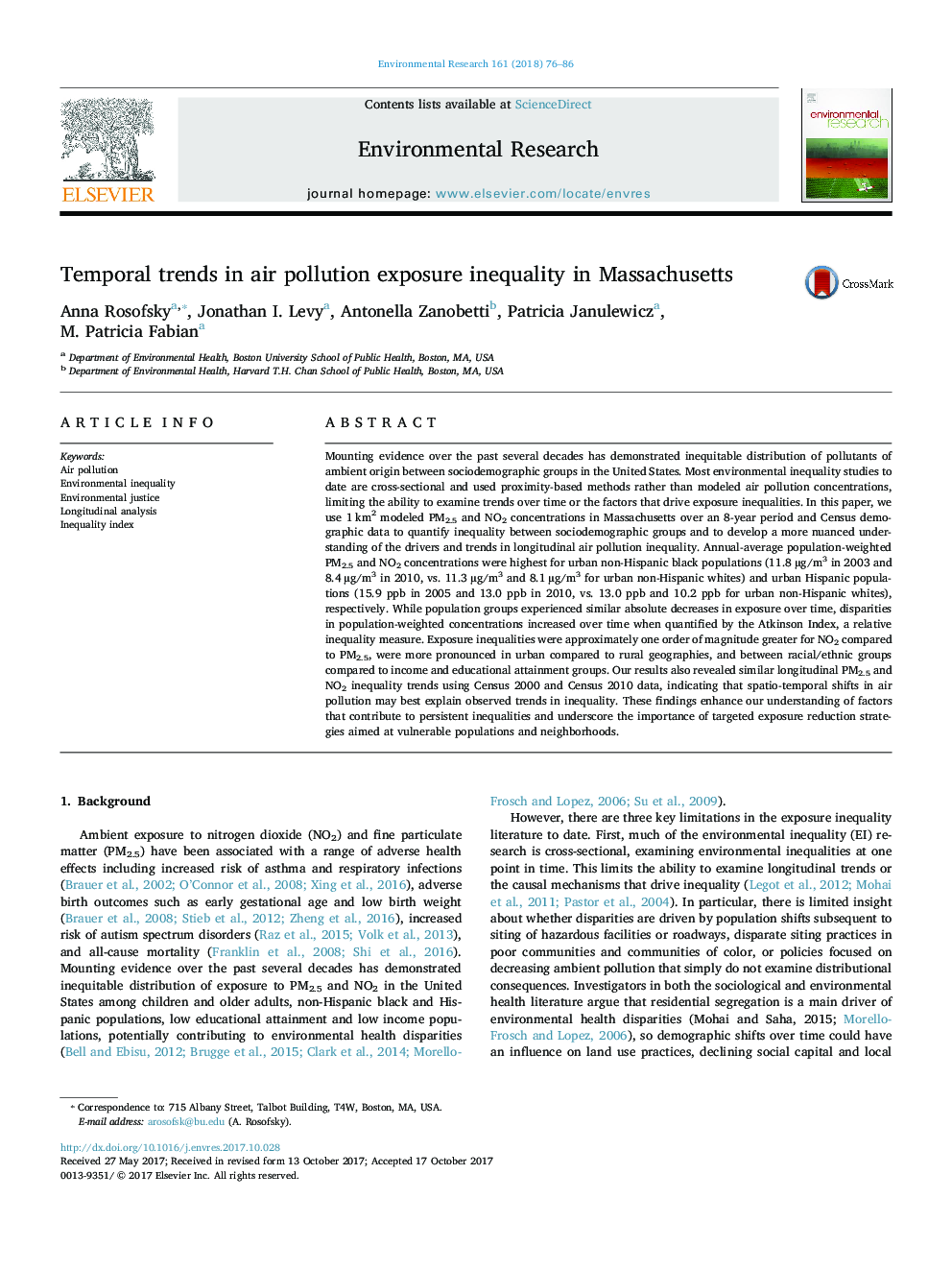| کد مقاله | کد نشریه | سال انتشار | مقاله انگلیسی | نسخه تمام متن |
|---|---|---|---|---|
| 8869233 | 1622542 | 2018 | 11 صفحه PDF | دانلود رایگان |
عنوان انگلیسی مقاله ISI
Temporal trends in air pollution exposure inequality in Massachusetts
ترجمه فارسی عنوان
روند زمانی در نابرابری های آلودگی هوا در ماساچوست
دانلود مقاله + سفارش ترجمه
دانلود مقاله ISI انگلیسی
رایگان برای ایرانیان
کلمات کلیدی
آلودگی هوا، نابرابری محیط زیست، عدالت محیطی، تجزیه طولی، شاخص نابرابری،
موضوعات مرتبط
علوم زیستی و بیوفناوری
علوم محیط زیست
بهداشت، سم شناسی و جهش زایی
چکیده انگلیسی
Mounting evidence over the past several decades has demonstrated inequitable distribution of pollutants of ambient origin between sociodemographic groups in the United States. Most environmental inequality studies to date are cross-sectional and used proximity-based methods rather than modeled air pollution concentrations, limiting the ability to examine trends over time or the factors that drive exposure inequalities. In this paper, we use 1 km2 modeled PM2.5 and NO2 concentrations in Massachusetts over an 8-year period and Census demographic data to quantify inequality between sociodemographic groups and to develop a more nuanced understanding of the drivers and trends in longitudinal air pollution inequality. Annual-average population-weighted PM2.5 and NO2 concentrations were highest for urban non-Hispanic black populations (11.8 µg/m3 in 2003 and 8.4 µg/m3 in 2010, vs. 11.3 µg/m3 and 8.1 µg/m3 for urban non-Hispanic whites) and urban Hispanic populations (15.9 ppb in 2005 and 13.0 ppb in 2010, vs. 13.0 ppb and 10.2 ppb for urban non-Hispanic whites), respectively. While population groups experienced similar absolute decreases in exposure over time, disparities in population-weighted concentrations increased over time when quantified by the Atkinson Index, a relative inequality measure. Exposure inequalities were approximately one order of magnitude greater for NO2 compared to PM2.5, were more pronounced in urban compared to rural geographies, and between racial/ethnic groups compared to income and educational attainment groups. Our results also revealed similar longitudinal PM2.5 and NO2 inequality trends using Census 2000 and Census 2010 data, indicating that spatio-temporal shifts in air pollution may best explain observed trends in inequality. These findings enhance our understanding of factors that contribute to persistent inequalities and underscore the importance of targeted exposure reduction strategies aimed at vulnerable populations and neighborhoods.
ناشر
Database: Elsevier - ScienceDirect (ساینس دایرکت)
Journal: Environmental Research - Volume 161, February 2018, Pages 76-86
Journal: Environmental Research - Volume 161, February 2018, Pages 76-86
نویسندگان
Anna Rosofsky, Jonathan I. Levy, Antonella Zanobetti, Patricia Janulewicz, M. Patricia Fabian,
